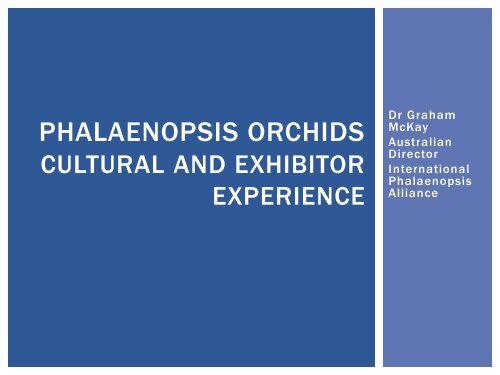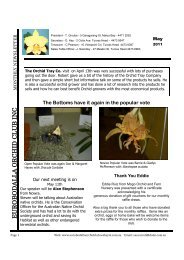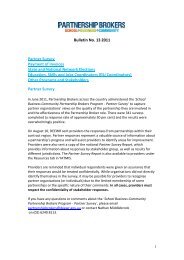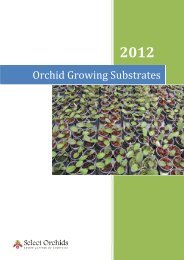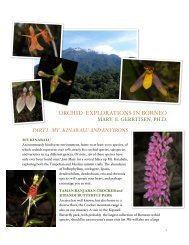Phalaenopsis Orchids: Dr Graham McKay
Phalaenopsis Orchids: Dr Graham McKay
Phalaenopsis Orchids: Dr Graham McKay
Create successful ePaper yourself
Turn your PDF publications into a flip-book with our unique Google optimized e-Paper software.
PHALAENOPSIS ORCHIDS<br />
CULTURAL AND EXHIBITOR<br />
EXPERIENCE<br />
<strong>Dr</strong> <strong>Graham</strong><br />
<strong>McKay</strong><br />
Australian<br />
Director<br />
International<br />
<strong>Phalaenopsis</strong><br />
Alliance
DTPS SUNLANDS DIAMOND PEARL 'GIGI'
IN THEIR NATURAL HABITAT<br />
PHALAENOPSIS ORCHIDS ARE EITHER:<br />
•EPIPHYTIC [growing on trees]<br />
•Occasionally SAPROPHYTIC [growing on rocks]<br />
Species have a distribution throughout SE Asia<br />
from India through Indonesia to Northern<br />
Australia and north to China and Taiwan.
PHALAENOPSIS ORCHID GROWTH FACTS<br />
OFTEN IGNORED BY THE PUBLIC INCLUDE:<br />
<strong>Phalaenopsis</strong> orchid growth facts often ignored by the public<br />
include:<br />
•MONOPODIAL squat growth with NO major moisture storage<br />
mechanism, such as a pseudobulb and can only rely on their fleshy<br />
leaves and roots for moisture storage.<br />
•In more temperate Australian conditions, they are unable to grow<br />
outside on or under trees or on exposed verandas.<br />
•They require more protected conditions which provide warmth and<br />
humidity [plus air movement], such as:<br />
1.Waterproof covered greenhouse [with heating in winter in<br />
temperate climates].<br />
2.Indoors with suitable natural or artificial lighting. Indoors can<br />
be winter only or year round, depending on the available residence<br />
and climate.
PHALAENOPSIS ORCHIDS ARE POPULAR!<br />
Close to 70% of all the<br />
orchids grown in the<br />
world are <strong>Phalaenopsis</strong><br />
because:
FLOWERING<br />
•Can be all year round, especially<br />
when the environment can be<br />
easily manipulated with<br />
temperature and air flow.
6. CULTURE<br />
•Ease of culture making it<br />
possible to grow a small plant<br />
rapidly into an impressive<br />
specimen within 3 – 4 years.
6. EASE OF CULTURE
LOTS OF FLOWERS!<br />
•Floriferous presentation<br />
with some specimens<br />
having in excess of 20 x<br />
160mm (6 inch) flowers
FLORIFEROUS
GREAT RESULTS SOONER!<br />
•Hybridisation progress can<br />
be spectacular with<br />
generational improvements<br />
within 3 years from<br />
pollination to flowering.
9.<br />
•Colourful presentation<br />
means that <strong>Phalaenopsis</strong><br />
have a complete range of<br />
colours.
9. COLOURFUL
GREAT RANGE!<br />
•Excellent range of<br />
presentation with long, wellshingled<br />
inflorescences or<br />
miniatures with hundreds of<br />
beautiful flowers.
10. EXCELLENT PRESENTATION
11.COMPACT & EASILY TRANSPORTED
LAST WELL!<br />
•Flowers are long-lasting for<br />
3 to 4 months
PHALAENOPSIS ARE EASY TO BREED!<br />
•Genetics are well<br />
understood as many<br />
standard <strong>Phalaenopsis</strong> are<br />
Tetraploid (4N)
DIVERSITY:<br />
•Wonderful range of variety<br />
presentations
MY VARIETIES EXHIBITED MELBOURNE<br />
AOC 2009.
LOTS OF DIFFERENT SPECIES!<br />
•Spectacular species with<br />
approximately 80 species<br />
described
SPECTACULAR SPECIES<br />
P.equestris 'alba'<br />
P.amabilis 'Snowy<br />
Mountain' TIOS 2009
EXHIBITING CAN BE CHALLENGING!<br />
•Exhibition challenge is the pinnacle<br />
of the orchid hobby to grow and<br />
culture a specimen with a high<br />
flower count, in pristine condition.<br />
This could take 3 months from first<br />
flower opening. This difficulty is<br />
often not accommodated by our<br />
Awards Judging.
EXHIBITION CHALLENGE<br />
P.Sunlands New Rain-Dancer 'Warrigal'<br />
HCC AOC 2004, 7 flower s, 4 buds, 101x116<br />
77.7pts<br />
Phal.Sunlands New Raindancer 'Warrigal'<br />
AM AOC 2006, 1 2 flower s, 2 buds, 97x117<br />
82pts
16B.<br />
P. amabilis 'Ben Yu' AM AOC . 2008, 13<br />
flower s, 2 buds,65x74<br />
81 .8pts<br />
P . a m a b ilis ' B e n Y u ' A M A O C A M A O S. 2009, ‘ B e s t<br />
in Show’ A O C M e e t ing 2 3 open f lowers, m a in<br />
s t e m – lower b ranch 5 f lowers open<br />
N o A w a rd Improvement.
LIGHT<br />
•Light reduction needs to be 70 to<br />
85%<br />
•Waterproof cover required due to<br />
growing media water application<br />
requirements.<br />
•Moveable reflective screens vary<br />
light transmission and help heating<br />
requirement.
HUMIDITY<br />
•70% Ideal<br />
•Enough to maintain leaf texture and control<br />
fungal flower petal blight (spotting)<br />
•Gravel floors increase humidity by evaporation<br />
but can have pest and fungal hygiene<br />
negatives.<br />
•Concrete floors are more hygienic.<br />
•Good air movement using overhead or wall<br />
mounted fans or even natural convection from<br />
a sloped or peaked roof with sidewalls that<br />
can be opened or closed.
TEMPERATURE<br />
•Ideally 15 to 28 C<br />
•Above 28 C, humidity must be higher<br />
together with good air movement. Leaf<br />
growth becomes more elongated with<br />
higher temperature.<br />
•PLANTS MUST BE DRY-CROWN and LEAVES<br />
below 15 C. Otherwise tissue damage<br />
occurs on the soft tissue of leaves. If<br />
unchecked then plants die. In small<br />
collection, drying the central crown with<br />
tissue will prevent cold damage.
TEMPERATURE (CONT)<br />
•Less watering in Winter and<br />
water early in day where weather<br />
is sunny and predictable<br />
•Overhead or wall mounted fans<br />
with good air movement<br />
generally dries plants
OVERHEAD FANS WITH DOUBLE LAYER<br />
AMPELITE SHEETING
TEMPERATURE (CONT)<br />
•Double trapped air insulation or double<br />
sheeting aids temperature control.<br />
•Wet walls provide temperature control and<br />
humidity improvement.<br />
•Gas heating of air with NO exhaust gas into hot<br />
house OR use Heat Sink Floors.<br />
•<strong>Dr</strong>op temperature below 25 C for 3 weeks to<br />
induce flowering. Depending on whether a<br />
mericlone is HIGH or LOW temperature variety,<br />
seller can tell you percentage of spiking that<br />
will result.
GROWING MEDIA<br />
Each grower has his or her<br />
favourite growing media and I<br />
cannot count the number of<br />
members who have recounted<br />
how good their particular media<br />
works.<br />
The choice of media comes down<br />
to:
HOW CHOICE OF MEDIA IS MADE:<br />
1. Economics of the material.<br />
2. Size of the collection and the KISS principal (KEEP<br />
IT SIMPLE STUPID!)<br />
3. Local authority water restrictions.<br />
4. Time available to re-pot/watering<br />
5. Climate of the particular area.<br />
6. Availability of consistent supply E.g. Orchidmate<br />
7. Potential problems with the media.<br />
8. Quality of the water supply (PH and salt content).
BASICALLY THERE ARE 3 MOST<br />
COMMONLY USED MEDIA:<br />
1. Composted Pine Bark<br />
2. Sphagnum Moss<br />
3. Coconut Husk
COMPOSTED BARK<br />
Fame <strong>Orchids</strong>, in Brisbane, is using<br />
composted bark (SA) mixed with 20%<br />
Perlite. Results are excellent. Leaf<br />
shape suggests higher light and<br />
temperature in Summer
ELONGATED LIGHT GREEN LEAVES
COMPOSTED BARK<br />
Fame <strong>Orchids</strong> Phally House<br />
Fame <strong>Orchids</strong> Roof
COMPOSTED BARK (CONT)<br />
Fame <strong>Orchids</strong> uses dam water. All of the<br />
plants were mericlone varieties that I<br />
imported from Taiwan and sold to him in<br />
November 2011 growing in COCONUT<br />
HUSK. Fame uses a fertilizer sourced<br />
from Horticultural Solutions. Good root<br />
and leaf growth. Root growth into media<br />
and early spiking of plants in May 2012.
BARK - GOOD LEAF AND ROOT GROWTH
BARK – ROOT GROWTH INTO MEDIA
BARK – EARLY SPIKING IN MAY
SPHAGNUM MOSS<br />
• Sphagnum moss is the most widely used commercial media<br />
for growing <strong>Phalaenopsis</strong> <strong>Orchids</strong>.Mr Hung uses Chinese<br />
Sphagnum because University Analysis in Taiwan found the<br />
Carbon/Nitrogen Ratio was 66.8 for Chinese moss compared<br />
to 144.6 for moss from Chile. New Zealand moss is similar to<br />
Chile. As a consequence, Chinese moss will resist developing<br />
a lower pH over one year of use. Unfortunately Chinese<br />
Sphagnum moss is not available in Australia and Mr Hung<br />
would advise increasing the ORGANIC fertilizer usage to<br />
compensate.<br />
• TIPS ON USING SPHAGNUM MOSS:<br />
• Separate your moss growing areas from other media being<br />
employed in a collection of different orchids.<br />
• Moisten moss first then squeeze out all the water<br />
• Use smaller pots with moss and ideally clear pots which can be<br />
the flexible type.<br />
• Tweeze the moss up and then pack it tightly with 3 downward<br />
strokes with a moss level about one inch from the top.
SPAGNUM (CONT)<br />
•DO NOT WATER or FERTILISE for 3 to 4 weeks. New roots will<br />
begin to form during this period. You can fertilise after the<br />
new roots begin to form.<br />
•Once a month you should DOUBLE WATER. First time water<br />
to the top of the pot and allow time to drain through the<br />
media. The second time will flush out the salts.<br />
•Roots are green when wet and white when dry. When roots<br />
are dry half way up the pot, it is time to water again.<br />
•Extra drainage is provided by granulated foam in the base of<br />
the pot particularly where night temperatures are low.<br />
•Foliar feeding is used to prevent excess algae growth. HY-<br />
SAN [Horticultural Solutions] 1 ml per Litre can also control<br />
algae and bacteria.
SPHAGNUM (CONT)<br />
• pH of moss is 4.0 to 4.5 and this is a natural inhibitor of phytoflora.<br />
• Foliar feeding can be weekly in hot periods of summer and twice<br />
monthly during winter.<br />
• Root growth is less with moss.<br />
• Grow deflasked plants for one year and then repot. If the moss is still<br />
fine then you can repot by placing new moss around the existing root<br />
ball.<br />
• You can trim roots to keep the pot smaller. Trim the roots one day and<br />
then repot the next day, This allows the cut roots to dry slightly.<br />
• Use taller pots for potting on when using moss.<br />
• FERTILIZER used should be:<br />
• Mono potassium Phosphate 1 in 1000<br />
• Fish Extract and Seaweed Extract Mixture in the ratio of 5:2. This<br />
mixture is used in a dilution of 1 in 1000. The seaweed extract<br />
contains natural hormones [cytokinins, Auxins, gibberellins and<br />
Alginic Acid] which promote root growth, multiple basal growths and<br />
multiple flower spikes. This mixture is used by Mr Hung AS A FOLIAR<br />
APPLICATION.
COCONUT HUSK:<br />
I chose to experiment with this media because of<br />
economics, KISS principal and water restrictions in SE<br />
Queensland.<br />
Coconut Husk (Orchidmate TM, available from Tinonee<br />
<strong>Orchids</strong> and Easy <strong>Orchids</strong>), was apparently PH<br />
adjusted already. I additionally treated it as follows:<br />
• Soak in Cultiplex Solution for 48 hours to reduce salt<br />
content and to ensure PH of 6.0 to 6.5.<br />
• Wash 3 times with rainwater.<br />
• Soak in HY-SAN (3ml per litre) to sterilise and then<br />
drain.
COCONUT HUSK:<br />
I used:<br />
•Coconut Husk 3 to 1 granulated foam<br />
for 3 to 5mm and 5 to 8mm grades.<br />
•Pure Coconut Husk used in 8 to 12mm<br />
size.<br />
•Clear pots with small basal layer<br />
granulated foam for drainage and root<br />
photosynthesis.
FERTILIZER PROGRAM:<br />
1. HSO22 1g per litre weekly.<br />
2. Mid-week Seasol 1ml/litre as foliar application.<br />
3. 2 weeks later mid-week, SEASOL +PLUS 1ml/litre<br />
as a foliar application.<br />
4. 2 weeks later rotate the program.<br />
5. In APRIL I supplemented with AMINO K<br />
(Horticultural Solutions).<br />
6. We used rainwater only. You will need to account<br />
for salt content of your water supply as this will<br />
influence the Electrical Conductivity (EC) Value or<br />
Salt Retention of your media.
EXPERIMENT WITH SPHAGNUM &<br />
COCONUT HUSK<br />
•I completed a rough<br />
experiment using plantlets<br />
planted in Sphagnum Moss<br />
and others in Coconut Husk.
REMEMBER THESE RESULTS FROM MY OWN EARLY<br />
EXPERIENCES WITH COCONUT HUSK:<br />
Compot Seedling Growth 3 months<br />
over winter in Coconut Husk.<br />
Compot Growth 3 months<br />
over winter Coconut Husk
EARLY EXPERIENCES:<br />
Compots 3 months over<br />
Winter<br />
Coconut 3 months- violacea<br />
types
MORE EXAMPLES:<br />
Mericlones – singles 3<br />
mths over Winter<br />
Deflasked seedlings in New<br />
Coconut Husk 3 weeks show<br />
new leaf and root growth
FACTORS INFLUENCING RESULTS:<br />
•My experiment passed on with over<br />
5000 plants I gave onto another<br />
exhibitor, unfortunately he did not<br />
have a covered, waterproof area or<br />
a hothouse until May 2012. Heavy<br />
rain during the period prior to this,<br />
and cold weather, had a dramatic<br />
impact. However, I have been able<br />
to see significant results.
EXAMPLES:<br />
TS 2165 SAME CROSS Left<br />
Coconut , Right Moss.<br />
TS 2165 Coconut- more<br />
root growth
TS 2165<br />
SAME PLANTS AT 10 MONTHS AFTER REPOT 6 MONTHS
MORE EXAMPLES:<br />
TS 2344- 6 months-Coconut<br />
more root growth<br />
TSH-110 More root Growth<br />
Coconut, plants similar sizes.
MORE EXAMPLES:<br />
TSH-110- 10 Months-note gravel<br />
on Moss- roots through Coconut<br />
TS 2279- Gravel orange- roots<br />
penetrate Moss
GM 1283-GREY ROCK - ROOTS DON'T PENETRATE MOSS<br />
PHOTO 29
CONCLUSION:<br />
1. Surprising how good the Composted Bark<br />
was.<br />
2. Root Growth better in Coconut and Bark.<br />
3. All these are fine substrate media,<br />
provided you use them according to their<br />
potential.<br />
4. Re-pot <strong>Phalaenopsis</strong> often to achieve<br />
better growth. Any media problems are<br />
then overcome. This is probably more true<br />
for Moss and Coconut Husk.
CAUGHT IN THE ACT. NOTE- TOP LEFT- P. DENDI'S MEH-TEH 'GIGI
21A. INSERT PHOTOS 31 & 32<br />
Phal Dendi's Meh-Teh 'GiGi'.<br />
P. Dendi's Meh-Teh 'GiGi<br />
No2' is a perfect Big Lip
P. DENDI’S HIGADON ‘WARRIGAL’
BIG LIP BREEDING:<br />
We should be very grateful for this line of<br />
breeding started by Dennis Diehm of<br />
Dendi <strong>Orchids</strong>, NSW. I have used all these<br />
plants, plus others from Taiwan in<br />
extensive Big Lip Breeding.<br />
Contact: Mr Barry Kable (Peter’s Glen<br />
Green Houses, Qld) if you wish to<br />
purchase any of my flasks.
I WILL MISS MY BREEDING, THESE WILL<br />
NEVER TO BE SEEN AGAIN!<br />
Big Lip Harlequin
MORE EXAMPLES OF MY BREEDING:<br />
GM736 Dtps Sunlands Pipe Queen<br />
'Warrigal' X[ P.Carolina Spring Beauty X<br />
Dtps King Shiang's Rose]<br />
Dtps [P.Sunlands Rain Dancer X Sunlands<br />
Gif t] X Dtps Sunlands Spring<br />
'Queenslander' HCC AOC.
MORE EXAMPLES OF MY BREEDING:<br />
Dtps Sunlands Pink Pearl<br />
'GiGi.<br />
Dtps Sunlands Mini Pearl
LIFE AFTER ORCHIDS!<br />
My son Matt <strong>McKay</strong> - Socceroo
TRAVEL!
COLLECTING INDIGENOUS ART!<br />
Molly Rogers<br />
Harry Tjutjuna
ENJOYING BEING GRANDAD!
TIME TO RELAX!


